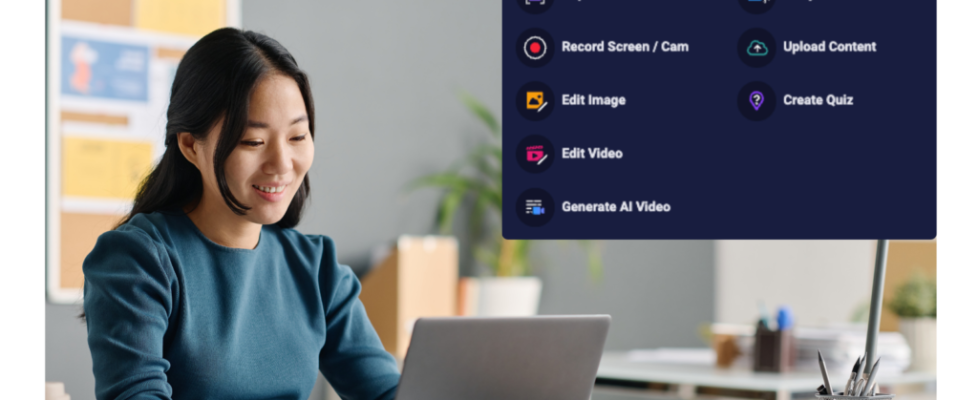“Learning is becoming more interactive, instead of individualistic,” said Homestead High School 10th grader Aryan Manglm. He’s a member of Homestead High School Future Business Leaders of America (FBLA) based out of Cupertino, CA. “For example, regular written homework assignments can now be transformed into videos for classmates to see too. That helps broaden our perspectives.”
Manglm and his fellow students collaborated with ScreenPal on projects through their business program. The group of about 90 students is dedicated to learning about business, how to run successful operations, and at the same time, get hands-on experience in video creation.
To them, video learning is making a huge impact on education and it will continue well after the pandemic.
Asynchronous Video Makes a Difference
When remote learning first started, students feared that it would change the way they connected with teachers. Some feared that they would be isolated at home. Others relayed feelings that they would be misunderstood. But after a year of remote learning, these students say teachers who implemented videos within their classes kept them engaged.
The student group found that video encouraged them to stay on task with their projects. It also helped them learn and comprehend new information. Most importantly, it helped them connect with their classmates while learning from home.
They urge educators to keep using videos even after students return to class.
Great Ways to Connect With Students
Katia Bravo, a sophomore at Homestead High, says Zoom wasn’t enough to help her feel closer to classmates during the pandemic.
“Everyone was muted with their cameras off, and only the teacher was talking,” she said.
The ability to see and hear her classmates made it easier for her to connect and work through projects. For Bravo, video filled the gap of learning and connection.
Helpful video creation tip:
While not everyone is comfortable on camera, students can show their faces while also protecting their privacy with green screen backgrounds.
Simply choose an image from ScreenPal’s expansive stock library to use as your background. Students could also choose to share only their screen.
Building Authentic Relationships with Teachers
 The student-teacher relationship is extremely important for learning. Students say asynchronous videos helped them build relationships with their teachers while learning from home.
The student-teacher relationship is extremely important for learning. Students say asynchronous videos helped them build relationships with their teachers while learning from home.
Homestead High freshman Aaditya Raj believes pre-recorded video allowed him to convey his thoughts and ideas with teachers.
He says, “Not only was I able to voice my opinions, but ScreenPal also allowed my teachers to understand the type of student I am since teachers are rarely presented with the opportunity to connect with their students through Zoom classes.”
Helpful video creation tip:
Video feedback helps students feel seen and understood.
Kate de Medeiros, Ph.D., a professor at Miami University in Ohio, recommends using asynchronous video to give personalized feedback on student assignments.
It’s as easy as opening the screen recorder and sharing the student’s work on the screen. Hit record to start sharing your feedback. Teachers can add a webcam for a personal touch.
Student Learning at Your Own Pace
With video, students are able to watch and learn at their own pace.
The ability to stop the video and take notes is an essential way for students to learn. They can rewatch video lessons anytime during their busy day. For 9th grader Samhitha Varanasi, she says videos helped her perform better.
“One thing that I have learned about myself during the pandemic is my tendency to perform better when teachers provide interactive resources such as recorded lectures that I can refer back to when self-studying,” she said.
Another student felt that teachers should continue using pre-recorded video even after the pandemic ends because it’s more personal and engaging than other standard teaching methods.
“It helps to have a permanent resource to refer back to, especially when working without the guidance of others,” said sophomore Daniel Lee.
Helpful video creation hint:
Students learn at different paces and ability levels, according to Elizabeth Pitel, a computer and financial literacy teacher at Chestnut Ridge Middle School in Sewell, New Jersey.
She suggests offering course materials in more than one format, such as a downloadable handout and a pre-recorded video. Doing so will better support students as they study at home.
Learning and Collaborating with ScreenPal
These valuable insights were in part due to collaboration with ScreenPal. The students learned career skills like video creation, marketing, product design, and public speaking. They participated in workshops with ScreenPal leaders, created videos and marketing materials, and are helping to kickstart a charity grant program.
In the near future, you’ll find more insights from these high schoolers. The entire ScreenPal team is grateful to work with the talented students of Homestead FBLA in Cupertino, CA.

































